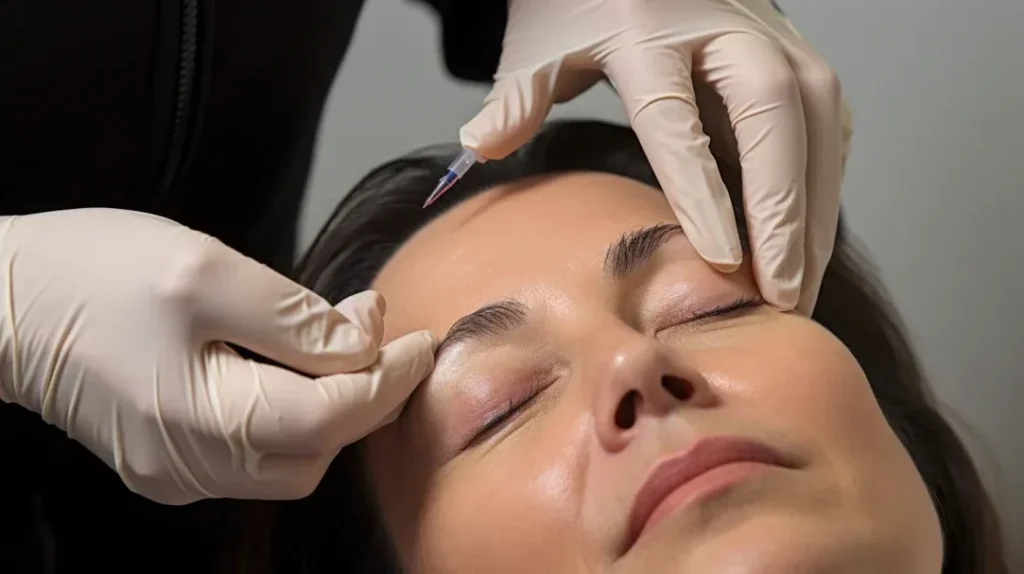Breaking the Chains: How Botox Offers Respite From Debilitating Migraines
Are you tired of the constant chains of debilitating migraines weighing you down? Look no further because Botox may be the key to your long-awaited respite.
In this article, we’ll explore how Botox emerged as a groundbreaking treatment for migraines, offering relief to countless sufferers like yourself. Imagine a life without the throbbing pain, light sensitivity, and nausea that accompany migraines.
Botox injections can significantly reduce the frequency and intensity of migraines, providing a much-needed break from the constant cycle of pain.
Get ready to break free and discover the transformative power of Botox for Migraines.
Key Takeaways
- Botox has shown efficacy in reducing the frequency and intensity of migraines, providing relief for sufferers.
- The Botox injection process for migraines involves specific targeted areas and techniques.
- Botox for migraine treatment has a generally safe profile, although potential risks and side effects should be considered.
- Suitable candidates for migraine treatment with Botox can be determined based on specific criteria, ensuring optimal results.
The Efficacy of Botox for Migraines Relief
The use of Botox for migraine relief has proven to be a significant advancement in the treatment of this chronic condition. Known primarily for its cosmetic applications, Botox has demonstrated considerable effectiveness in reducing the frequency and severity of chronic migraines.
Clinical research supports the efficacy of Botox in this therapeutic context. Studies indicate that regular Botox injections can lead to a substantial reduction in the number of migraine days experienced by patients each month. Additionally, there’s evidence to suggest a decrease in the intensity of migraine symptoms, making it a beneficial treatment for those who suffer from chronic migraines.
The process of recovering from Botox treatment for migraines is typically swift. Most patients notice a decrease in migraine frequency and intensity within one to two weeks following their injections. While Botox is generally well-received, some individuals may experience minor side effects, such as temporary discomfort at the injection site or slight muscle weakness.
Patients need to be aware that the dosage and administration protocol of Botox for migraine prevention differs significantly from its use in cosmetic procedures. The feedback from patients who have received Botox treatments for migraines has been predominantly positive, with many reporting a marked improvement in their quality of life due to the reduction in migraine frequency and severity.
The Botox Injection Process for Migraines

Botox injections for migraine relief involve a specific process administered by a healthcare professional experienced in this treatment, typically a neurologist or headache specialist. Here’s an overview of the procedure:
Administration and Target Areas
- Professional Administration: The treatment is conducted by a qualified healthcare provider experienced in administering Botox for migraines.
- Targeted Injection Sites: Botox is injected into several areas around the head and neck, which are commonly associated with migraine pain. These include the forehead, temples, back of the head, and neck. The exact injection sites can vary based on the individual’s symptoms and pain patterns.
Injection Technique
- Multiple Small Injections: The procedure involves several tiny injections. A fine needle is used to inject Botox into the targeted muscles.
- Minimal Discomfort: The procedure is usually well-tolerated with minimal discomfort, thanks to the small needle size.
Post-Treatment Care and Considerations
- Immediate Resumption of Activities: Most patients can resume their normal activities immediately following the procedure.
- Pre-Treatment Evaluation: Before undergoing Botox injections for migraines, patients typically undergo a thorough evaluation to determine if this treatment is appropriate for their specific case.
- Post-Treatment Guidelines: Patients may be advised to temporarily avoid certain activities or medications after receiving Botox injections.
Safety and Regulatory Standards
- Approved Use: Botox injections for migraines are a well-established treatment and are regulated to ensure patient safety and effective care.
- Consistent Follow-up: Regular follow-up appointments are usually recommended to assess the treatment’s effectiveness and plan future sessions.
It’s important for individuals considering Botox injections for migraines to consult with a healthcare professional to understand the benefits, risks, and expected outcomes of this treatment.
Safety Profile and Potential Risks of Botox for Migraine Treatment
Continuing the discussion from the previous subtopic, let’s delve into the safety profile and potential risks of using Botox for migraine treatment. Botox is a safe and effective option for managing chronic migraines. However, like any medical procedure, there are potential risks and considerations to keep in mind. It is important to note that Botox treatment for migraines should only be performed by trained healthcare professionals experienced in its use.
Some of the potential risks include temporary muscle weakness or paralysis, bruising or pain at the injection site, and allergic reactions. It is also essential to consider the long-term effects of Botox on migraines, as well as the ethical aspects of using Botox for medical conditions. Overall, the safety profile of Botox for migraine treatment is favorable. Still, it is crucial to thoroughly discuss with your healthcare provider to ensure patient safety and fully understand the potential risks involved.
| Safety Profile of Botox for Migraine Treatment | Potential Risks of Botox for Migraine Treatment |
|---|---|
| – Botox is generally safe and well-tolerated | – Temporary muscle weakness or paralysis |
| – Minimal side effects reported | – Bruising or pain at the injection site |
| – Allergic reactions are rare | – Allergic reactions |
| – Long-term effects on migraines are positive | – Ethical considerations |
Criteria for Determining Suitable Candidates for Migraine Treatment With Botox
Determining whether a patient is suitable for Botox treatment for migraines involves a thorough evaluation based on specific criteria. Healthcare professionals consider several factors before recommending this treatment:
- Neurological Health Assessment: An in-depth examination of the patient’s neurological health is essential. This includes reviewing their medical history and any neurological disorders that might impact the treatment’s suitability or effectiveness.
- Chronic Migraine Diagnosis: Botox is typically considered for patients diagnosed with chronic migraines. This usually means experiencing headaches on 15 or more days per month, with migraine symptoms on at least 8 of those days.
- Previous Treatment Efficacy: The patient’s response to other migraine treatments is evaluated. If traditional methods, such as oral medications, have been ineffective or caused intolerable side effects, Botox might be considered.
- Potential Benefits of Botulinum Toxin Type A: The specific benefits of botulinum toxin type A, the active ingredient in Botox, are considered. Its role in pain management and muscle relaxation is assessed in the context of the patient’s migraine symptoms.
- Consideration of Recent Innovations: Any recent advancements or innovations in migraine treatment are also considered, ensuring the patient receives the most up-to-date and effective treatment options.
- Lifestyle and Migraine Triggers: The patient’s lifestyle, including diet, exercise, and stress levels, is reviewed. Understanding triggers and lifestyle factors plays a crucial role in developing a comprehensive treatment plan, which may include Botox.
- Customized Treatment Plans: Treatment plans are personalized, considering the individual’s specific migraine patterns, severity, and overall health.
Understanding that Botox treatment for migraines is not a one-size-fits-all solution is crucial. The decision to use Botox is made after careful consideration of these factors, and patients need to have a detailed discussion with their healthcare provider to understand the potential benefits and risks of this treatment in their specific case.
Comparing Botox to Other Migraine Management Strategies
When considering treatment options for migraines, you may wonder how Botox compares to other strategies for managing this debilitating condition. Here’s a comparison to help you understand the benefits of Botox in migraine management:
- Non-surgical solutions for migraines: Botox offers a non-invasive approach to migraine relief, unlike surgical interventions that may carry higher risks and longer recovery times.
- Alternative therapies for migraine relief: Botox provides an alternative to traditional medications, offering a different mechanism of action that targets the neurological pathways involved in migraines.
- Non-pharmacological headache interventions: Botox offers a non-pharmacological option for those who prefer to minimize their use of medications or haven’t found success with other treatments.
- Migraine impact on daily life: Botox can significantly reduce the frequency and intensity of migraines, allowing individuals to regain control over their daily activities and overall quality of life.
Frequently Asked Questions
How Long Does It Take for Botox to Start Working for Migraines?
Botox usually takes a few days to a week to start working for migraines. Don’t worry if you don’t see immediate results; it can take a few injections to experience the full benefits.
Can Botox Completely Eliminate Migraines?
Botox won’t wholly eliminate migraines for everyone, but it can provide significant relief. By targeting specific muscles, Botox helps reduce the frequency and intensity of migraines, giving you a much-needed respite from the chains of debilitating pain.
Are There Any Long-Term Side Effects of Using Botox for Migraines?
Long-term side effects of using Botox for migraines are rare, but potential risks include muscle weakness, neck pain, and allergic reactions. Consult a healthcare professional to discuss your concerns and determine the best treatment plan.
Does Insurance cover Botox for Migraine Treatment?
Yes, Botox is sometimes covered by insurance for migraine treatment. You must check with your insurance provider to determine if Botox injections for migraines are included in your coverage.
Can Botox Be Used as a Preventative Measure for Migraines, or Is It Only for Treating Existing Migraines?
Botox can be used as a preventative measure for migraines, not just for treating existing ones. It’s ironic how a cosmetic treatment can offer relief, but studies have shown its effectiveness in reducing migraine frequency and intensity.
Conclusion
Congratulations on taking the first step towards a life free from the chains of migraines.
With Botox, you can finally experience the relief you’ve longed for. Say goodbye to the throbbing pain and hello to a brighter, pain-free future.
Embrace the transformative power of Botox and break free from the grip of migraines.
Your journey towards respite starts now.

